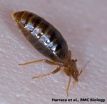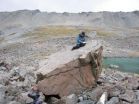House-sharing with microbes
2010-09-09
(Press-News.org) Household dust contains up to 1000 different species of microbes, with tens of millions of individual bacterial cells in each gram. And these are just the ones that can be grown in the lab!
Dr Helena Rintala, speaking at the Society for General Microbiology's autumn meeting in Nottingham describes how we share our living and working spaces with millions of microbes, not all of whom are bad news.
Microbes are a part of our normal environment and can be both beneficial and detrimental to our health. "Exposure to microbes in childhood can prevent the development of allergies. On the other hand, mould growth can increase the risk of asthma," said Dr Rintala from the National Institute for Health and Welfare in Finland.
In indoor environments microbes thrive on surfaces that are occasionally moist or wet, for example in the kitchen and bathroom. Prolonged damp anywhere in the house can lead to greater numbers of microbes. "These microbes, their spores and the molecules they secrete can be released into the air which can lead to health problems if they are breathed in," she said.
Dr Rintala explains why it is important to study the microbes, both good and bad, that typically live in indoor environments. "When you consider that we spend more than 90% of our lifetime in indoor environments and breathe the indoor air with all its components, it is important to know that the environment is healthy and that the air is safe to breathe," she said.
The Finnish group is working towards identifying microbial species that are important to our health - both good and bad - and developing rapid detection methods for them. "Culture methods are slow and selective – but with the development of new DNA-based methods we can assess the indoor air quality of homes and workplaces more rapidly, enabling people to take faster action if there is a problem," said Dr Rintala.
INFORMATION: END
ELSE PRESS RELEASES FROM THIS DATE:
2010-09-09
Yeast could be a powerful ally in the discovery of new therapeutic drugs to treat Parkinson's disease says a scientist presenting his work at the Society for General Microbiology's autumn meeting in Nottingham today.
Dr Tiago Fleming Outeiro from the Instituto de Medicina Molecular in Lisbon, Portugal describes how his group is slowly uncovering the molecular basis of Parkinson's disease by studying the associated human protein in yeast cells.
Parkinson's disease is a neurodegenerative disorder without any known cure that affects around 6 million people worldwide. The ...
2010-09-09
In the latest issue of the journal Nature, Miguel Godinho Ferreira, Principal Investigator at the Instituto Gulbenkian de Ciência (IGC) in Portugal, lead a team of researchers to shed light on a paradox that has puzzled biologists since the discovery of telomeres, the protective tips of chromosomes: while broken chromosome ends generated by DNA damage (such as radiation or cigarette smoke) are quickly joined together, telomeres are never tied to each other, thus allowing for the correct segregation of the genetic material into all cells in our body. Since telomeres erode ...
2010-09-09
Male bedbugs are known to be very unfussy when it comes to mating, mounting any well-fed bug they can see - regardless of age or gender. Researchers writing in the open access journal BMC Biology have discovered how immature bedbug nymphs, who would be harmed by the traumatic insemination technique practiced by the males, release alarm pheromones to deter this unwanted attention.
Vincent Harraca, from Lund University, Sweden, worked with a team of researchers to stage encounters between males and females or nymphs. He said, "The chemical communication, as well as the ...
2010-09-09
By studying similarities in the genes of Scots Pine trees, scientists have shown that the iconic pine forests of Highland Scotland still carry the traces of the ancestors that colonised Britain after the end of the last Ice Age, harbouring genetic variation that could help regenerate future populations, according to new results published in the journal Heredity.
The research was carried out by an international team from the Centre for Ecology & Hydrology, the Polish Academy of Sciences, the University of Edinburgh and the Macaulay Land Use Research Institute.
Today's ...
2010-09-09
As the last ice age was ending, about 13,000 years ago, a final blast of cold hit Europe, and for a thousand years or more, it felt like the ice age had returned. But oddly, despite bitter cold winters in the north, Antarctica was heating up. For the two decades since ice core records revealed that Europe was cooling at the same time Antarctica was warming over this thousand-year period, scientists have looked for an explanation.
A new study in Nature brings them a step closer by establishing that New Zealand was also warming, indicating that the deep freeze up north, ...
2010-09-09
Cancer immunotherapy calls for revised clinical endpoints that differ from those used for chemotherapy, according to an article published online September 8 in The Journal of the National Cancer Institute.
Unlike chemotherapy, which acts directly on tumors, cancer immunotherapies exert their effects on the immune system, which may delay or change response patterns, perhaps owing to the dynamics of the immune system itself. For example, initial tumor burden may increase due to lymphocytic infiltration, because of T-cell proliferation, which is followed by lymphocyte-induced ...
2010-09-09
BOSTON, Mass. (September 8, 2010)‹Scientists have discovered a small
molecule that helps human cells get rid of the misfolded, disfigured
proteins implicated in Alzheimer¹s disease and other neurodegenerative
ailments. This potential drug could have applications for other conditions
as well.
Cells create and discard proteins continuously, a process that relies on a
balance between the speed with which new proteins are created and damaged
ones destroyed. Protein destruction occurs through a sophisticated system
that marks proteins for disposal by tagging them with ...
2010-09-09
LA JOLLA, CA - September 7, 2010 –A team of scientists from The Scripps Research Institute, the Genomics Institute of the Novartis Research Foundation (GNF), and the U. S. Naval Research Detachment in Peru has completed a study that could improve the efficacy of diagnosis and treatment strategies for drug-resistant malaria.
In the new study—published online on September 9, 2010 by the journal Genome Research—the scientists analyzed the genomic features of a population of malaria parasites in Peru, identifying the genetic basis for resistance to a common antibiotic.
Malaria ...
2010-09-09
GAITHERSBURG, Md. – Using a one-of-a-kind instrument designed and built at the National Institute of Standards and Technology (NIST), an international team of researchers have "unveiled" a quartet of graphene's electron states and discovered that electrons in graphene can split up into an unexpected and tantalizing set of energy levels when exposed to extremely low temperatures and extremely high magnetic fields. Published in this week's issue of Nature,* the new research raises several intriguing questions about the fundamental physics of this exciting material and reveals ...
2010-09-09
The Johns Hopkins Children's Center top pediatrician is urging a "rethink" of a new sickle cell screening program, calling it an enlightened but somewhat rushed step toward improving the health of young people who carry the sickle cell mutation.
Beginning this fall, all Division I college athletes will undergo mandatory screening for the sickle cell trait. The program, rolled out by the National Collegiate Athletic Association (NCAA), is an attempt to prevent rare but often-lethal complications triggered by intense exercise in those who carry the genetic mutation yet ...
LAST 30 PRESS RELEASES:
[Press-News.org] House-sharing with microbes



